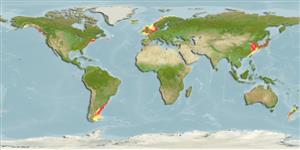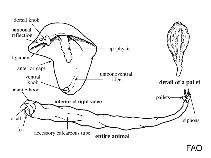Teredo navalis Linnaeus, 1758
Naval shipworm| Native range | All suitable habitat | Point map | Year 2050 |

|
| This map was computer-generated and has not yet been reviewed. |
| Teredo navalis AquaMaps Data sources: GBIF OBIS |
Upload your photos
Google image | No image available for this species;
drawing shows typical species in Teredinidae.
Google image | No image available for this species;
drawing shows typical species in Teredinidae.
Classification / Names Common names | Synonyms | CoL | ITIS | WoRMS
Bivalvia | Myida | Teredinidae
Environment: milieu / climate zone / depth range / distribution range Ecology
Benthic; brackish; depth range 0 - 150 m (Ref. 76971), usually 0 - 20 m (Ref. 75831). Temperate; 11°C - 25°C (Ref. 98650); 72°N - 58°N, 25°W - 31°E
Distribution Countries | FAO areas | Ecosystems | Occurrences | Introductions
Northeast Atlantic: Native to Iceland, Faroe and Norway. Introduced to the Baltic Sea, Mediterranean and Pacific Ocean. Temperate to tropical.
Length at first maturity / Size / Weight / Age
Maturity: Lm ? range ? - ? cm Max length : 50.0 cm TL male/unsexed; (Ref. 76971)
Short description Morphology
Body reddish and with a characteristic elongate worm-like shape. Anterior part covered by a small (up to 2 cm long) reduced helmet-like shell consisting of two triangular-shaped parts (anterior and posterior lobes similar), which is white with light brown periostracum (outermost layer). This shell acts as a wood-boring instrument. The brownish soft worm-like body lies in a calcareous tube up to 60 cm long and 1 cm in diameter.
Inhabits wooden material (logs, pilings, ships, other submerged wooden constructions) from temperate to tropical zones (Ref. 76974). Salinity tolerance: 5-35 parts per mille (Ref. 78117). Considered a pest and an invasive species as it destroys submerged wood (Ref. 76971).
Life cycle and mating behavior Maturity | Reproduction | Spawning | Eggs | Fecundity | Larvae
Female phase: 8-10 weeks after larval stage; females larviparous, i.e., deposits living larvae instead of eggs; fertilized eggs develop through half of the larval period in the maternal gill chambers. Primary male phase: after 4-6 weeks of larval stage in warm temperatures, up to 6 months in colder temperatures with total length range 2-3 cm and 0.2 body diameter (Ref. 78112). It displays poecilogonony as its reproductive strategy (Ref. 99837).
Main reference
References | Coordinator | Collaborators
Harms, J. 1993. (Ref. 2711)
IUCN Red List Status (Ref. 130435: Version 2024-1)
CITES status (Ref. 108899)
Not Evaluated
CMS (Ref. 116361)
Not Evaluated
Threat to humans
Potential pest
Human uses
Fisheries: of no interest
| FishSource |
Tools
More information
Trophic Ecology
Food items
Diet
Food consumption
Ration
Predators
Diet
Food consumption
Ration
Predators
Ecology
Population dynamics
Life cycle
Human Related
Aquaculture profile
Stamps, Coins Misc.
Stamps, Coins Misc.
Outreach
References
Internet sources
BHL | BOLD Systems | CISTI | DiscoverLife | FAO(Publication : search) | Fishipedia | GenBank (genome, nucleotide) | GloBI | Gomexsi | Google Books | Google Scholar | Google | PubMed | Tree of Life | Wikipedia (Go, Search) | Zoological Record
Estimates based on models
Preferred temperature
(Ref. 115969): 8.1 - 20.2, mean 10.9 (based on 964 cells).
Price category
(Ref. 80766):
Unknown.



